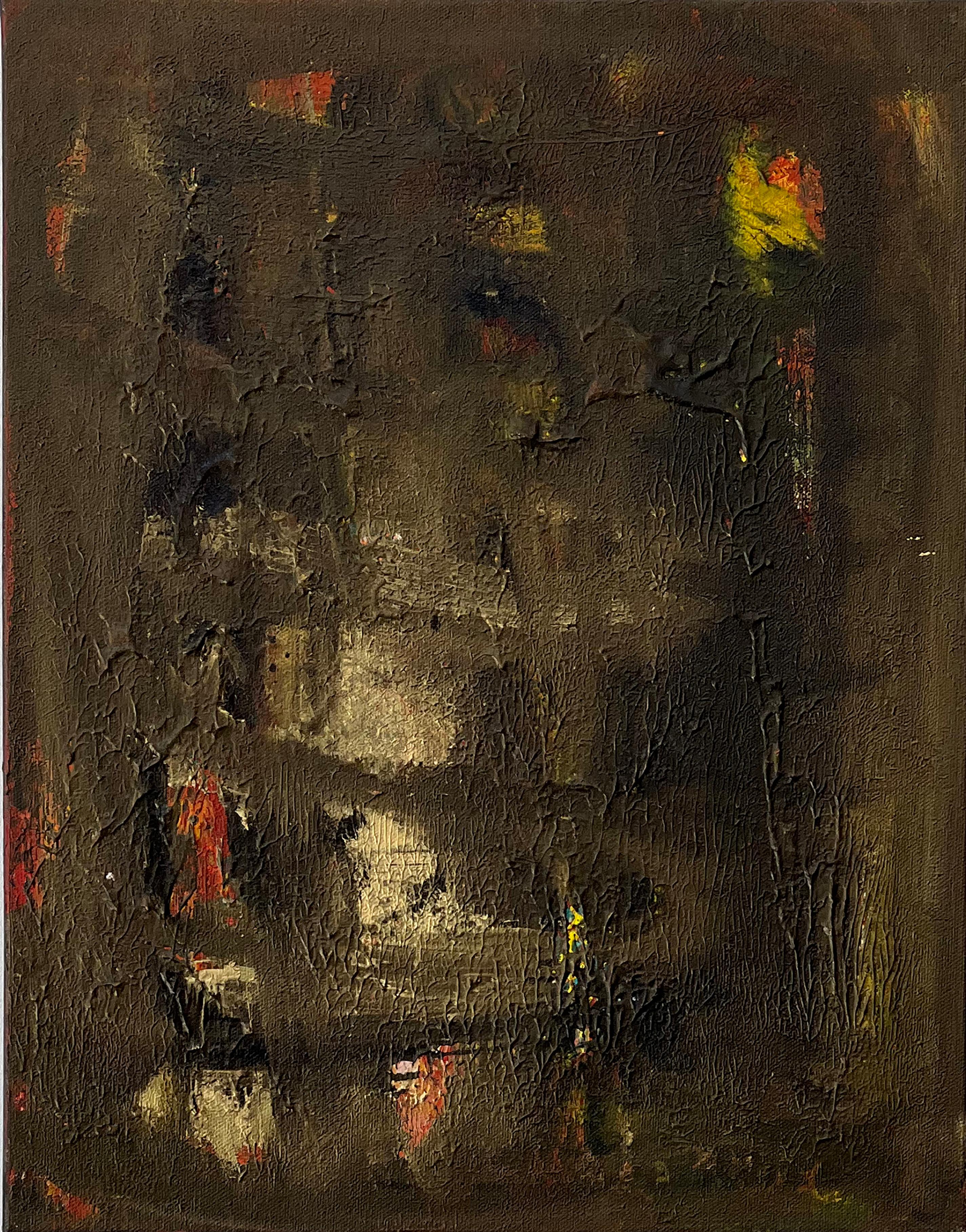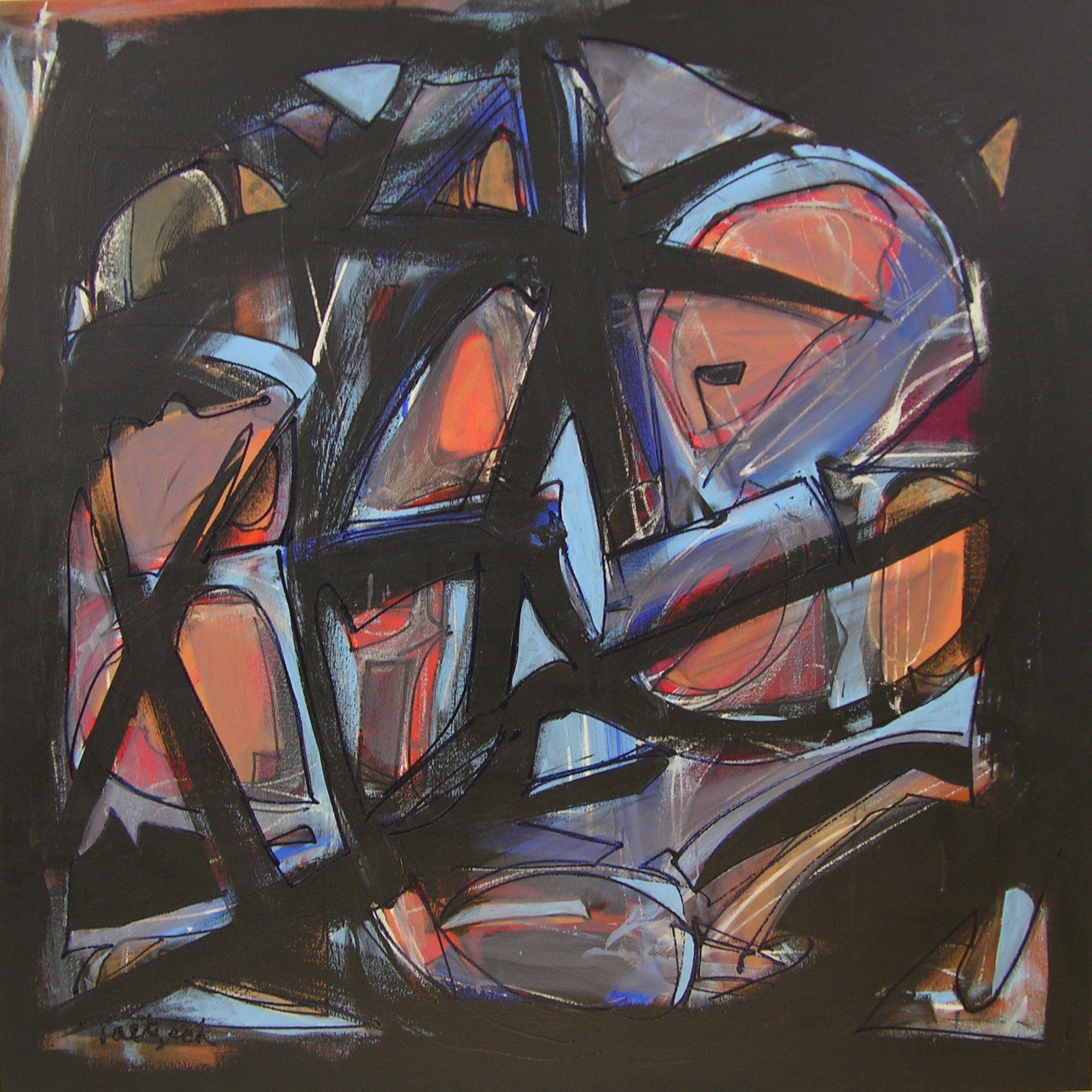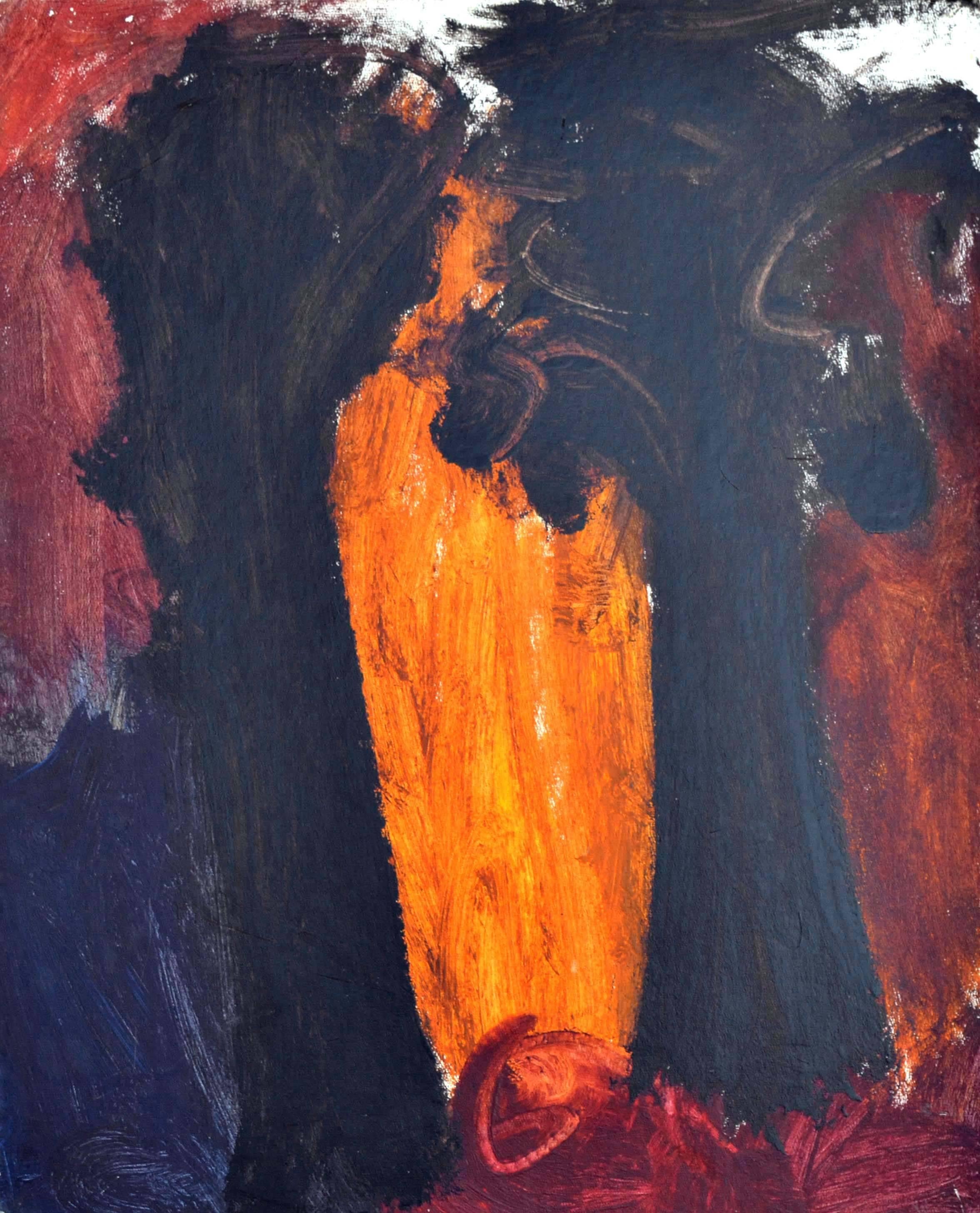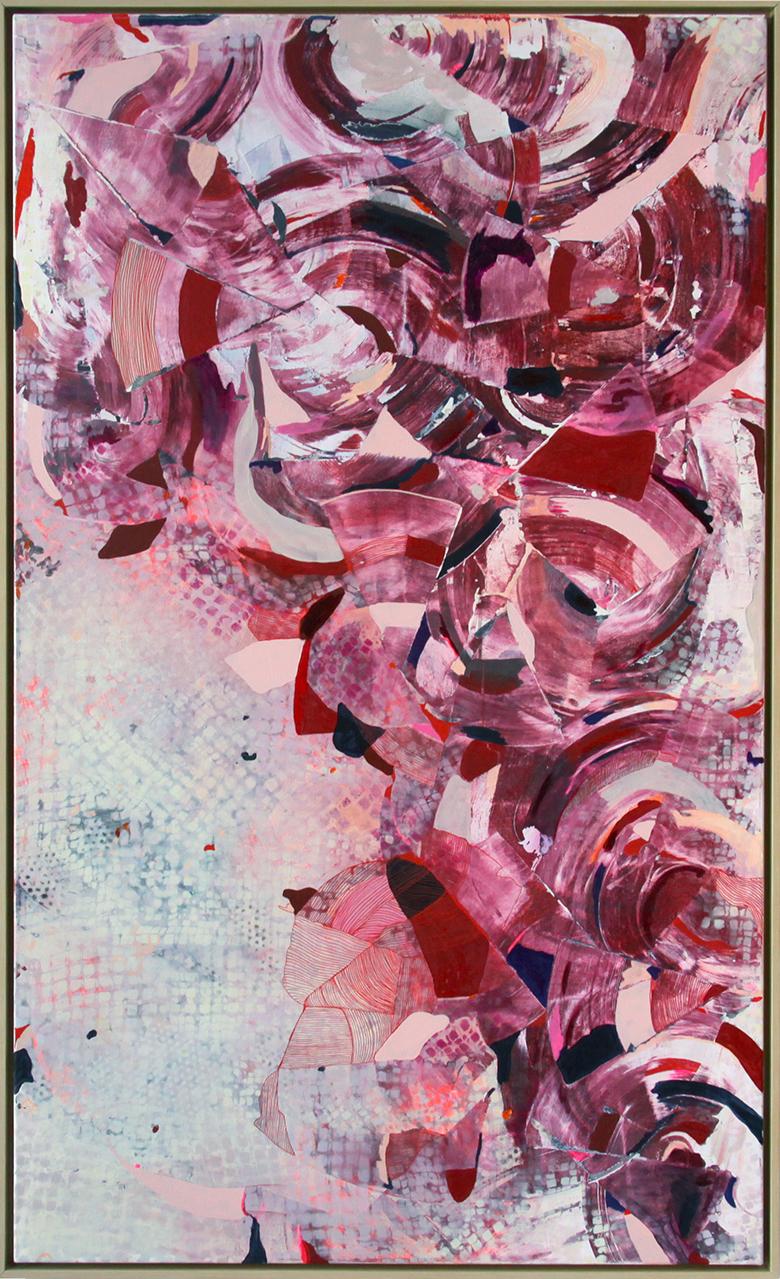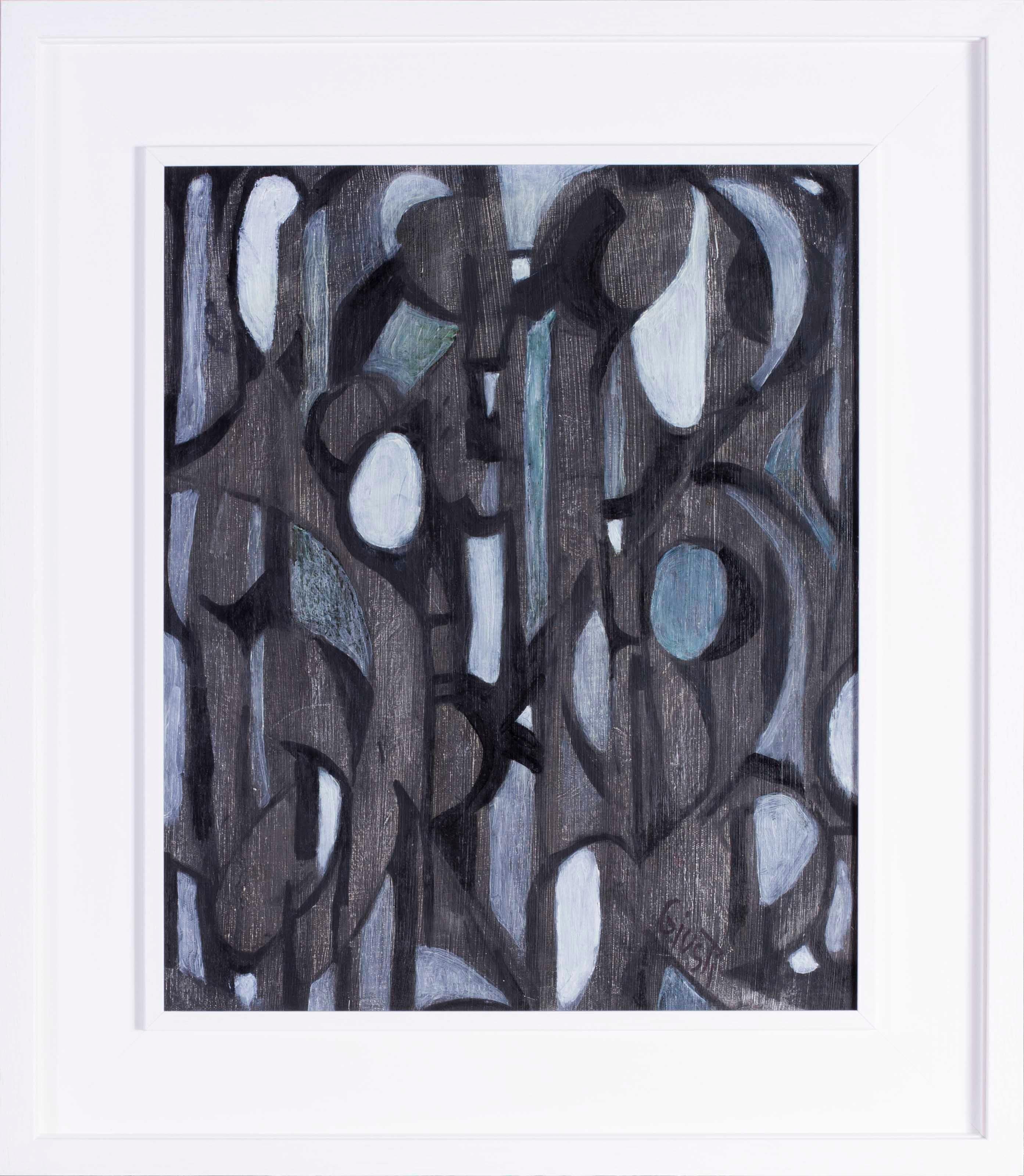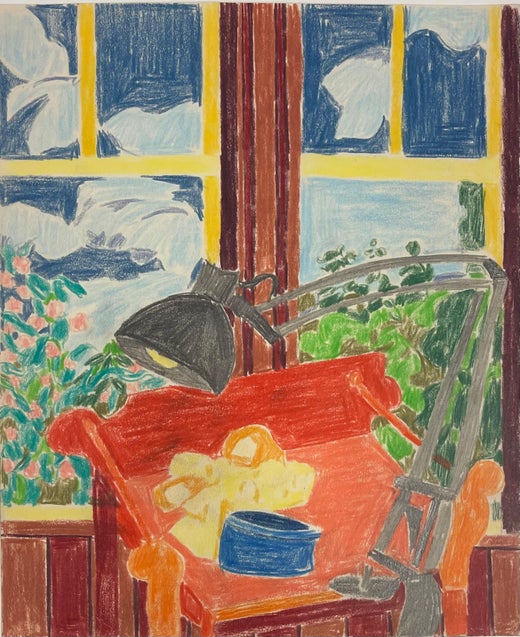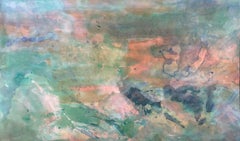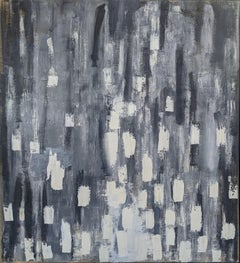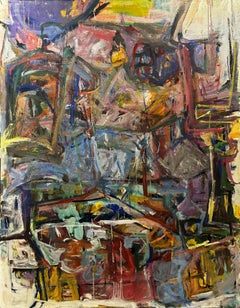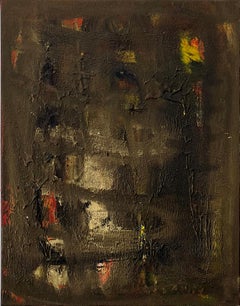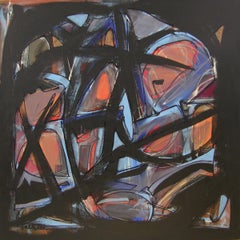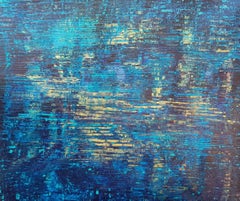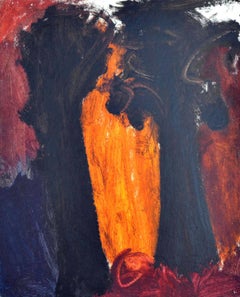Items Similar to "Twilight Imagery" Lynne Drexler, 1976 Abstract Dark Chromatic Composition
Want more images or videos?
Request additional images or videos from the seller
1 of 10
Lynne Drexler"Twilight Imagery" Lynne Drexler, 1976 Abstract Dark Chromatic Composition1976
1976
$44,000
$55,00020% Off
£33,520.69
£41,900.8720% Off
€38,255.04
€47,818.8020% Off
CA$61,830.41
CA$77,288.0220% Off
A$67,384.27
A$84,230.3420% Off
CHF 35,682.88
CHF 44,603.6020% Off
MX$809,356.05
MX$1,011,695.0620% Off
NOK 451,753.10
NOK 564,691.3820% Off
SEK 415,342.54
SEK 519,178.1820% Off
DKK 285,722.73
DKK 357,153.4120% Off
About the Item
Lynne Drexler
Twilight Imagery, 1976
Signed and dated on the reverse
Oil on canvas
30 1/2 x 22 1/2 inches
Southern-born Lynne Mapp Drexler found her artistic voice during one of the most exciting and significant art movements of the 20th century. Born in Newport News, Virginia, in 1928, Drexler began her study of art as a child.
Her parents, who were very supportive of both the visual and performing arts, enrolled Drexler in various art courses. Her early introduction to music would directly influence her later mature work. After attending the College of William and Mary, Drexler became interested in contemporary art. She was encouraged to explore this venue by her uncle, who had ties to the Hudson River School of painting, and by some of her more influential teachers.
After moving to New York in 1956, Drexler immersed herself in the world of Abstract Expressionism studying with Hans Hofmann in both his Provincetown and New York schools. It would be Hofmann's work as a colorist and his theories on color that would be one of Drexler's most significant influences. She eventually went on to study with another well known artist and teacher, Robert Motherwell, at Hunter College. His intellectual views on Abstract Expressionism guided Drexler's own process of creating art. Her academic training from Motherwell, along with the lessons of color theory from Hofmann, would set the foundation for the style of painting for which she is known. Drexler's swatch-like patterns and painterly blossoms of color are quite unique when compared to her contemporaries of the Abstract Expressionist genre. By 1961, Drexler would have her first solo show at the Tanager Gallery.
In 1961, Drexler married painter John Hultberg, whom she met at the Artists Club. The couple was already integrated into the bohemian lifestyle of the New York art scene. To occasionally escape the pressures of New York, Hultberg's art dealer, Martha Jackson, bought him a house on Monhegan Island, Maine, which had a small summer art colony. For Drexler, summering on the island would be a major sea-change in her life. The solitude of the island and the inspiration of the natural surroundings would impact her artistic career. Drexler would sketch outdoors on the island. Back in New York during the winters, these sketches were reimagined into large colorful abstract paintings. Also, when in New York, she would frequent the opera and sketch during the performances.
These musically influenced sketches would also become incorporated into an entire series of oil paintings. Unlike her male counterparts, Drexler found it difficult finding gallery representation in the gender-biased atmosphere of the New York gallery world. Hultberg, on the other hand, was quite successful and was considered a talented up-and-comer as an abstract artist. The relationship between Drexler and Hultberg was often tumultuous and the couple would routinely separate throughout their lives. Although respectful of one another's work, they would continue to grow distant.
As the mid 1960s approached, the movement of Abstract Expressionism was coming to a close, being replaced by Pop Art and, shortly there-after, Op Art. At some point in Drexler's painting career, Abstract Expressionism had become artistically "bankrupt" for her. She would also lament that "[New York] was no longer a place of stimulation for me. I had no respect for most of the artists working there. They were out to make it. They had no commitment to art." Drexler was already making her own natural transition. to abstract landscape painting. Many of her paintings created just after 1962 are clearly inspired by the landscape with the concepts of musical elements helping to guide the pictorial arrangements. Drexler's affinity with nature and music became deeply intertwined in her work.
Unhappy with the male-dominated art system and art politics of New York, Drexler finally moved permanently to Monhegan Island in 1983. She had become an integral member of the year-round island community. The remoteness and solitude of the island would impact her work. Her paintings often reflect the everyday routines of life such as views from her windows, interior views of her house and even chores such as hanging laundry. The still life also became an important subject in Drexler's repertoire, often floral arrangements peppered with dolls from her collection. These depictions came to symbolize her acceptance and appreciation for her life on the island.
Drexler summed up her artistic career on the island stating, “I sell enough here to make a living off of. I am not rich…but I have what I want. I mean as long as I have food, heat, roof over my head, food for the cat, and paint I am happy. Oh and Jack Daniel’s.”
When Drexler was diagnosed with cancer and given a prognosis of three to six months to live, her biggest fear was that she would have to die on shore. Her closest friends became her hospice care group which allowed her the dignity of staying on the island. Drexler passed away in 1999 on Monhegan Island surrounded by her friends and fellow islanders. After her death, the estate had been bequeathed to her friends who were charged with the difficult task of assessing her body of work. While extracting the many paintings from the Drexler house, the executors of the estate, as well as the townspeople, were shocked to realize the magnitude and multitude of paintings. Works of art not seen for decades were pulled from the basement, closets and even from under mattresses. It was revealed that Drexler, who was very hesitant to talk about her career as an artist in New York, had not divulged the fact that these paintings even existed, including masterpieces from the era of Abstract Expressionism.
The first comprehensive exhibition of Drexler's work ran at the Monhegan Museum in 2008 and also at the Portland Museum of Art in 2008 and 2009. The exhibition was organized by the Monhegan Historical and Cultural Museum Association. Since then, her work has been exhibited widely in New York, Chicago, and Southern California. In 2018, a comprehensive European exhibition of the women of Abstract Expressionism, which included Drexler, occurred in London. In 2022, one of her works sold for over a million dollars for the first time.
- Creator:Lynne Drexler (1928-1999, American)
- Creation Year:1976
- Dimensions:Height: 30.5 in (77.47 cm)Width: 22 in (55.88 cm)
- More Editions & Sizes:Unique WorkPrice: $55,000
- Medium:
- Movement & Style:
- Period:
- Condition:
- Gallery Location:New York, NY
- Reference Number:1stDibs: LU1841215579312
Lynne Drexler
Southern-born Lynne Mapp Drexler found her artistic voice during one of the most exciting and significant art movements of the 20th century. Born in Newport News, Virginia, in 1928, Drexler began her study of art as a child. After attending the College of William and Mary, Drexler became interested in contemporary art. She was encouraged to explore this venue by her uncle, who had ties to the Hudson River School of painting. After moving to New York in 1956, Drexler immersed herself in the world of Abstract Expressionism studying with Hans Hofmann in both his Provincetown and New York schools. She eventually went on to study with Robert Motherwell, at Hunter College. His views on Abstract Expressionism guided Drexler's own process. Her academic training from Motherwell would set the foundation for the style of painting for which she is known. Drexler's swatch-like patterns and painterly blossoms of color are quite unique when compared to her contemporaries of the Abstract Expressionist genre. By 1961, Drexler would have her first solo show at the Tanager Gallery. In 1961, Drexler married painter John Hultberg, whom she met at the Artists Club. The couple was already integrated into the bohemian lifestyle of the New York art scene. To occasionally escape the pressures of New York, Hultberg's art dealer, Martha Jackson, bought him a house on Monhegan Island, Maine, which had a small summer art colony. These musically influenced sketches would also become incorporated into an entire Unlike her male counterparts, Drexler found it difficult finding gallery representation in the gender-biased atmosphere of the New York gallery world. Hultberg, on the other hand, was quite successful and was considered a talented up-and-comer as an abstract artist. The relationship between Drexler and Hultberg was often tumultuous and the couple would routinely separate throughout their lives. As the mid 1960s approached, the movement of Abstract Expressionism was coming to a closet. She would also lament that "[New York] was no longer a place of stimulation for me. I had no respect for most of the artists working there. They were out to make it. They had no commitment to art." Drexler was already making her own natural transition. to abstract landscape painting. Many of her paintings created just after 1962 are clearly inspired by the landscape with the concepts of musical elements helping to guide the pictorial arrangements. Unhappy with the male-dominated art system and art politics of New York, Drexler finally moved permanently to Monhegan Island in 1983. The remoteness and solitude of the island would impact her work. Her paintings often reflect the everyday routines of life such as views from her windows, interior views of her house and even chores such as hanging laundry. When Drexler was diagnosed with cancer her biggest fear was that she would have to die on shore. Her closest friends became her hospice care group. Drexler passed away in 1999 on Monhegan Island.
About the Seller
5.0
Platinum Seller
Premium sellers with a 4.7+ rating and 24-hour response times
Established in 2022
1stDibs seller since 2022
132 sales on 1stDibs
Typical response time: <1 hour
- ShippingRetrieving quote...Shipping from: New York, NY
- Return Policy
More From This Seller
View All"Untitled (Park Avenue Series)" Beryl Barr-Sharrar, 1979 Color Field Abstraction
Located in New York, NY
Beryl Barr-Sharrar
Untitled (Park Avenue Series), 1979
Signed and dated on the reverse
Acrylic on canvas
44 x 73 1/2 inches
As an undergraduate at Mount Holyoke College (Beryl McLe...
Category
1970s Color-Field Abstract Paintings
Materials
Canvas, Acrylic
"Untitled" Calvert Coggeshall, Abstract Expressionism, Black, Grey, and White
Located in New York, NY
Calvert Coggeshall
Untitled, 1958
Oil on Canvas
38 H. x 36 W. inches
Provenance:
The artist's estate
Calvert Coggeshall worked as an abstract painter and interior designer primarily in Maine and New York City. From 1951 to 1978, he exhibited regularly with the Betty Parsons Gallery, and later with its successor, the Jack Tilton Gallery.
Born in Whitesboro, New York, Coggeshall started his career as an interior designer, working on commissions for clients in the New York City area. He later consulted on the interior designs for Henry Dreyfuss' line of cruise/cargo ships called American Export, popular from the 1940s through the 1960s. In the 1940s, he also worked with inventor Arthur Young to design interiors for the first full-sized scale of Bell helicopter models...
Category
1950s Abstract Abstract Paintings
Materials
Canvas, Oil
"Untitled" Diana Kurz, circa 1961-1962 New York Abstract Expressionist School
By Diana Kurz
Located in New York, NY
Diana Kurz
Untitled, circa 1961 - 1962
Oil on canvas
72 x 58 inches
Diana Kurz lives and works in the Soho neighborhood of New York City. She was born in Vienna, Austria and emigra...
Category
1960s Abstract Expressionist Abstract Paintings
Materials
Canvas, Oil
"Lexington, " Larry Zox, Abstract Expressionism, Minimalism, Brown Modernism
By Larry Zox
Located in New York, NY
Larry Zox
Lexington, 1973
Acrylic on canvas
61 x 49 inches
Provenance:
Andre Emmerich Gallery, New York
Janie C. Lee Gallery, Houston, Texas
Private Collection, Greenwood Village, Colorado
Exhibited:
New York, Andre Emmerich Gallery, Larry Zox: New Paintings, March 10 - 28, 1973.
Houston, Texas, Janie C. Lee Gallery, Larry Zox, February - April, 1974.
A painter who played an essential role in the Color Field discourse of the 1960s and 1970s, Larry Zox is best known for his intensely and brilliantly colored geometric abstractions, which question and violate symmetry. Zox stated in 1965: “Being contrary is the only way I can get at anything.” To Zox, this position was not necessarily arbitrary, but instead meant “responding to something in an examination of it [such as] using a mechanical format with X number of possibilities." What he sought was to “get at the specific character and quality of each painting in and for itself,” as James Monte stated in his introductory essay in the catalogue for Zox’s 1973–74 solo exhibition at the Whitney Museum of American Art. Zox also at times used a freer, more intuitive method, while maintaining coloristic autonomy, which became increasingly important to him in his later career.
Zox began to receive attention in the 1960s, when he was included in several groundbreaking exhibitions of Color Field and Minimalist art, including Shape and Structure (1965), organized by Henry Geldzahler and Frank Stella for Tibor de Nagy, New York, and Systemic Painting (1966), organized by Lawrence Alloway for the Guggenheim Museum. In 1973–74, the Whitney’s solo exhibition of Zox’s work gave recognition to his significance in the art scene of the preceding decade. In the following year, he was represented in the inaugural exhibition of the Hirshhorn Museum, which acquired fourteen of his works.
Zox was born in Des Moines, Iowa. He attended the University of Oklahoma and Drake University, and then studied under George Grosz at the Des Moines Art Center. In 1958, Zox moved to New York, joining the downtown art scene. His studio on 20th Street became a gathering place for artists, jazz musicians, bikers, and boxers. He occasionally sparred with visiting fighters. He later established a studio in East Hampton, a former black smithy used previously by Jackson Pollock.
Zox’s earliest works were collages consisting of pieces of painted paper stapled onto sheets of plywood. He then produced paintings that were illusions of collages, including both torn- and trued-edged forms, to which he added a wide range of strong hues that created ambiguous surfaces. Next, he omitted the collage aspect of his work and applied flat color areas to create more complete statements of pure color and shape. He then replaced these torn and expressive edges with clean and impersonal lines that would define his work for the next decade.
From 1962 to 1965, he produced his Rotation series, at first creating plywood and Plexiglas reliefs, which turned squares into dynamic polygons. He used these shapes in his paintings as well, employing white as a foil between colors to produce negative spaces that suggest that the colored shapes had only been cut out and laid down instead of painted. The New York Times noted in 1964: “The artist is hip, cool, adventurous, not content to stay with the mere exercise of sensibility that one sees in smaller works.”
In 1965, he began the Scissors Jack series, in which he arranged opposing triangular shapes with inverted Vs of bare canvas at their centers that threaten to split their compositions apart. In several works from this series, Zox was inspired by ancient Chinese water vessels...
Category
1970s Abstract Expressionist Abstract Paintings
Materials
Canvas, Acrylic
$44,000 Sale Price
20% Off
"Study for TH" Diana Kurz, Mid-Century Push And Pull Abstract Expressionist Work
By Diana Kurz
Located in New York, NY
Diana Kurz
Study for TH
Pastel and gouache on paper
21 1/2 x 20 inches
Diana Kurz (born 1936) is an Austrian-born feminist painter. In 1938, Diana Kurz's family fled Austria, first...
Category
1960s Abstract Expressionist Abstract Drawings and Watercolors
Materials
Paper, Pastel, Gouache
"Wildness Lies in Wait" William Littlefield, Abstract Expressionism
Located in New York, NY
William Littlefield
Wildness Lies in Wait, 1956
Signed and dated lower left; signed, dated and titled on the reverse
Oil on canvas
48 x 25 inches
William Horace Littlefield was bor...
Category
1950s Abstract Expressionist Abstract Paintings
Materials
Canvas, Oil
You May Also Like
Night in the Woods - acrylic on canvas
Located in West Hollywood, CA
Nina is an artist, ceramist and colorist with 20 years of professional experience and a lifetime of art appreciation. Originally from Virginia and having traveled and lived extensively worldwide she now resides as a full-time artist and ceramist in Los Angeles.
With a degree in psychology and training in ceramics, painting was a natural transition and expansion to her repertoire from an early age. With color and form as her guide, her artwork flows from spontaneous and spiritual inspiration. Influenced by her travels with the play of color and light, her paintings reflect nature, spirit and a place of tranquility. There’s a touch of magic, secrets and a touch of the unknown in every painting, when painting ”time...
Category
2010s Abstract Abstract Paintings
Materials
Canvas, Acrylic
Night, Painting, Acrylic on Canvas
By Lynne Taetzsch
Located in Yardley, PA
Night is a dark painting but not without hope and light as we look beneath the darkness, inside the darkness, to see what there is in the world to behold. 36â€
Category
2010s Abstract Abstract Paintings
Materials
Acrylic
Midnight sunset, Painting, Acrylic on Canvas
By Ivana Olbricht
Located in Yardley, PA
An original abstract painting captures the tranquil beauty of an imaginary midnight sunset over the ocean surface. The palette knife technique creates a textured and dynamic composi...
Category
2010s Abstract Abstract Paintings
Materials
Acrylic
Abstract Expression in Black
By Julius Wasserstein
Located in Soquel, CA
Abstract Velvety Black strokes he is known for by Julius Wasserstein (American, 1924-1985). Monogram initials "JW" bottom right. Intialed "JW" lower right corner and signed "Julius ...
Category
1960s Neo-Expressionist Abstract Paintings
Materials
Oil, Board
Abstract Expressionist Painting, "Dark Joy"
Located in San Diego, CA
This is a one of a kind original abstract expressionist painting by local San Diego artist, Kelsey Overstreet. This painting is 37.5 x 61.75 x 2.5. I...
Category
2010s Abstract Expressionist Abstract Paintings
Materials
Acrylic
French 20th Century abstract painting by Frederique Giusti 'Erosion II', blacks
By Frederique Giusti
Located in Petworth, West Sussex
Frederique Giusti (French, b. 1925)
Erosion II
oil on canvas laid down on board
signed ‘Giusti’ (lower right)
18 x 15 in. (45.7 x 38 cm.)
Category
20th Century Abstract Expressionist Abstract Paintings
Materials
Canvas, Oil
More Ways To Browse
Monhegan Island
Vintage Doll Collection
Winslow Oil Painting
Yvonne Rainer
Zahra Shahcheraghi
1960 Fenton
3 Dimensional Wood Art
60x30 Painting
Abstract Ocean Sky Painting
Abstract Painting 1940 France
Alan Reynolds
Ali Enache
Alma Woodsey Thomas
Amy Meyer
Andee Axe
Art Concrete Construction
Art Rosenbaum
Bitcoin Paintings
